When I first started managing social media for my first brand, I felt like I was constantly throwing spaghetti at the wall. Every day was a scramble to come up with something — anything — to post. Some days it was a motivational quote; other days, it was a rushed product promo. Engagement was inconsistent, my team was frustrated, and honestly, so was I.
It wasn't until a bit later down the line when I learned about content pillars for social media that things started to click. Instead of guessing what to post, I had a clear roadmap. My posts became more consistent, engagement rates improved, and planning for socials became a lot less stressful.
So, if your social media planning feels a bit chaotic, you‘re definitely not alone. I’ve been there myself and I know just how overwhelming it can be. Content pillars helped me bring some much-needed structure and focus to the process, and they still do today. With that said, let's get into what content pillars actually are and how they can help you, too.
Table of Contents
- What are content pillars?
- Why Content Pillars Matter
- Types of Content Pillars to Consider
- How to Identify Your Ideal Content Pillars
- How to Create Content Pillars for Social Media
- Content Pillars for Social Media Examples
Without content pillars, posting can feel pretty random and disconnected. But when you have a few strong pillars in place, holding up your overall strategy, everything gets a lot easier.
Pillars give you a structure to work from without boxing you in. I like to think of it like building a house; the pillars are what keep everything standing, but you still have plenty of room to decorate it however you want.
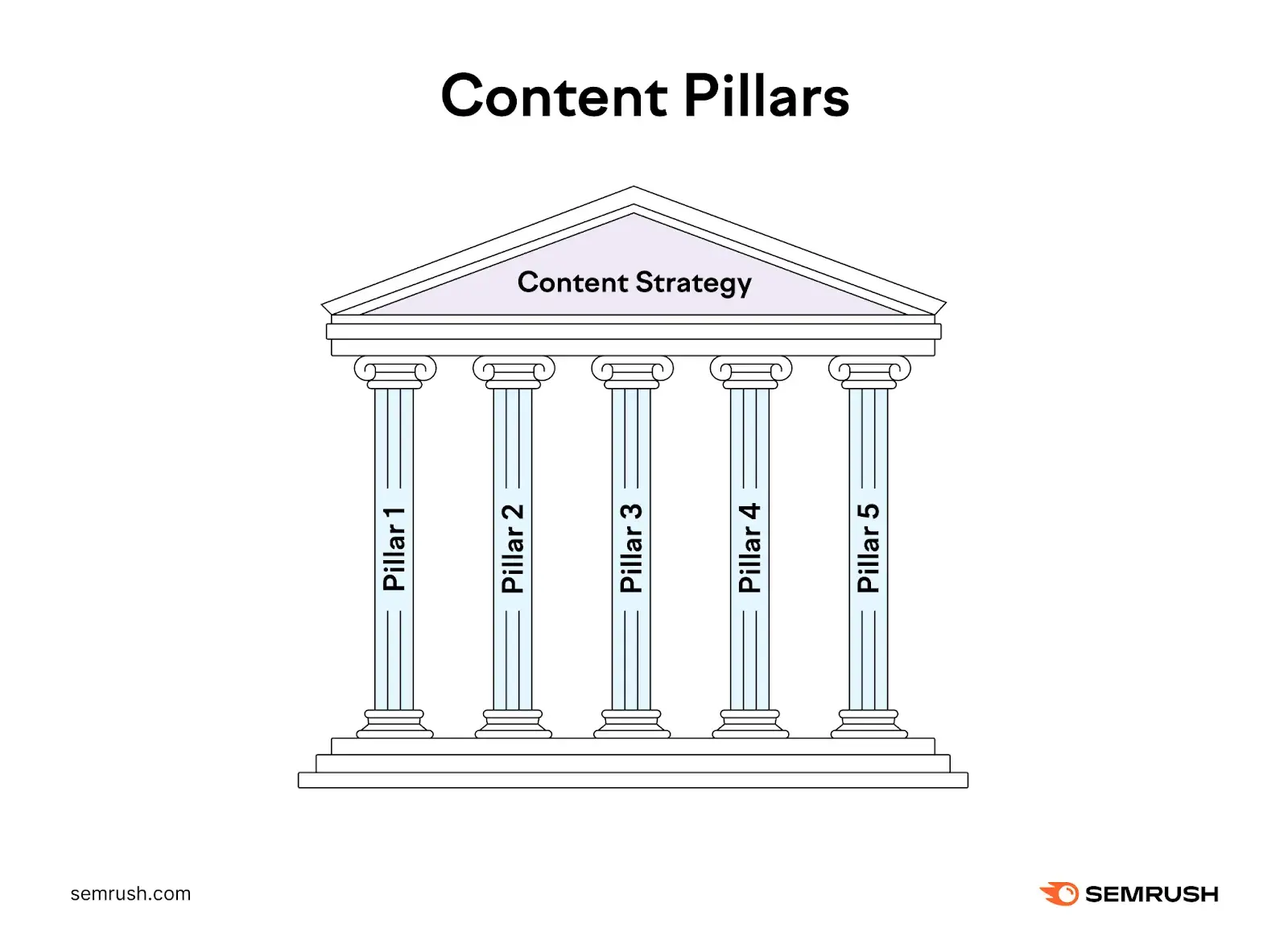
When you’re thinking about content pillars for social media marketing, there are a few common categories that tend to work for most brands:
- Educational. Sharing tips, how-tos, or resources that help your audience learn something useful.
- Inspirational. Motivational quotes, success stories, or anything that sparks positive emotion.
- Promotional. Highlighting your products, services, launches, or special offers.
- Community-building. Asking questions, starting conversations, and encouraging user-generated content.
- Behind-the-scenes. Showing the human side of your brand — your team, process, or day-to-day moments.
You don’t have to stick to these exactly, but having a few go-to categories like this can make it so much easier (and less stressful) to plan your social content. I’ll dive into how to actually build yours a little later on.
Why Content Pillars Matter
When I first started experimenting with content pillars, I didn't realize just how much they would transform not just my planning process, but also the way my audience connected with our brand. Once I saw the difference firsthand, it was hard to imagine going back to posting without a plan.
Here are a few reasons why having clear content pillars can make such a big impact
They streamline your content creation process.
Sitting down to plan a month’s worth of posts usually ended with me staring at a blank calendar, feeling stuck and overwhelmed. I’d sit there staring at the screen for way too long, struggling to come up with ideas that actually made sense together.
Once I had a few solid pillars to work with, everything started to fall into place. Brainstorming got faster, scheduling felt less hectic, and I wasn’t second-guessing every post. It was a simple shift, but it made a huge difference.
Turns out a lot of people feel the same. Having a documented strategy is one of the habits that sets successful marketers apart. In fact, 80% of very successful content marketers have a documented content strategy — and content pillars are often a big part of making that possible.
They keep your messaging consistent.
Another big shift I noticed? Our messaging became way more consistent.
When you’re jumping between unrelated topics, it’s easy for your brand voice to get lost. I noticed a huge difference once our posts tied back to a few key themes. It felt more cohesive, and over time, it helped reinforce what we wanted our brand to stand for. Our audience knew what to expect from us, and trust started to build.
If you're aiming for stronger brand recognition, staying consistent really matters. In fact, 68% of organizations say that brand consistency has contributed at least 10% to their revenue growth.
Pro tip: One thing that helped me was doing a quick “pillar check” before posting. I'd ask myself, “Which pillar does this support?” If I couldn’t answer clearly, it was a sign to rethink or refine the post.
They help you engage your audience more effectively.
One of the biggest benefits I noticed after building out our content pillars was how much better our posts connected with our audience. When you’re posting about topics your followers genuinely care about (and expect from you), engagement almost always goes up.
I’ve definitely seen this firsthand — posts tied to our content pillars consistently outperformed random one-off content in likes, comments, and shares.
Plus, it’s not just about the short-term boost. Showing up consistently around core topics makes it easier to build a community, and it’s great for staying visible in social media algorithms, which tend to favor steady engagement over sporadic viral hits.
But I’ll let the numbers speak for themselve: Did you know that brands that posted consistently at least five times per week grew their audience 2-3x faster than those that posted inconsistently, according to recent research by Buffer?
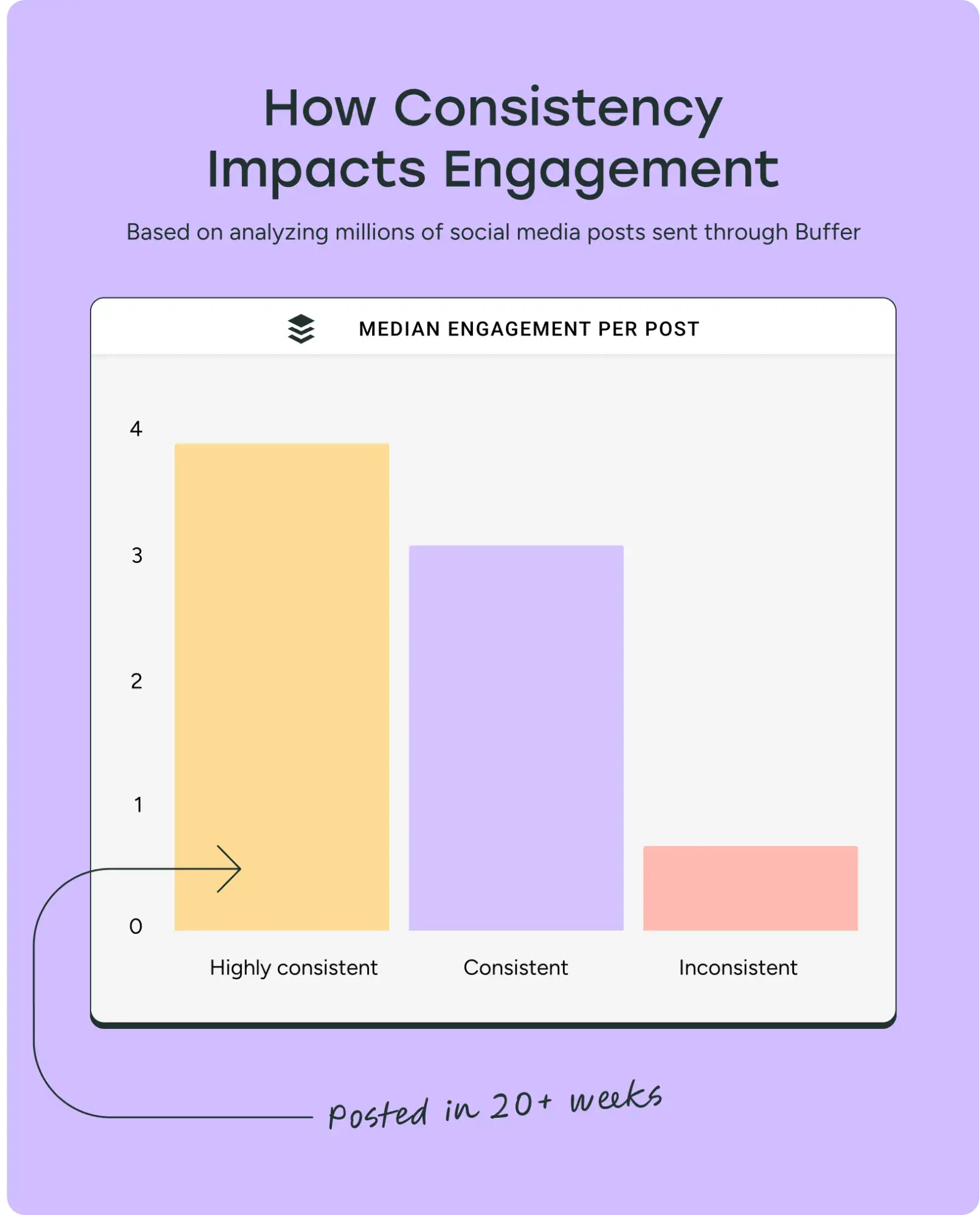
They make content repurposing easier.
One of the best parts about working with content pillars is how much easier it is to repurpose. Instead of starting from scratch for every post, you can take one strong idea and spin it into different formats — whether that's a blog post, a short video, a carousel, or a handful of social posts.
In my experience, having a clear set of pillars easily doubled the amount of usable content I could create from just one brainstorming session. Plus, it kept our messaging tight and made it easier to stay consistent across platforms without feeling repetitive.
According to a recent report, 48% of B2B marketers say a lack of content repurposing is one of their biggest challenges when it comes to scaling content production. It's easy to see why. Without a clear framework, turning one idea into different formats can feel like a lot.
I’ll give you a real example:
Based on the educational content pillar — which was one of the main pillars for a recent B2B sales tech company I worked with — I had the idea to create a survey to gather our own original data.
After analyzing the results, I wrote a comprehensive report to highlight the biggest insights. But I didn’t stop there. I broke down key statistics from the report into bite-sized pieces and shared them across social media over several weeks. I also turned major insights into short videos, carousels, and infographics, all carefully mapped back to the educational pillar.
This approach helped us extend the life of the research and reach different segments of our audience without overdoing it.
They improve your content strategy results.
At the end of the day, social media isn’t just about showing up — it’s about supporting your bigger goals. After I first started organizing my strategy around content pillars, one of my clients saw a 25% increase in traffic from social media to their website over the first six months. Not too shabby.
Content pillars gave me a way to stay focused, create posts that actually mattered to our audience, and get way more mileage out of every idea. I’ve been using content pillars ever since — and honestly, I can't imagine building a strategy without them now.
Still not convinced? Stick with me.
Back when we first talked about what content pillars are, I mentioned five common categories that most brands lean on. Now, let’s dig a little deeper. Each type of pillar plays a different role in your strategy, and understanding how they work can make it easier to plan your social content.
Educational
Educational content is all about teaching your audience something new or helping them solve a problem. This pillar focuses on giving value first — whether it’s through tips, tutorials, how-to guides, or breaking down complex topics into something easy to understand.
Personally, educational content has been a major pillar for almost every brand I’ve worked with. It’s one of the easiest ways to build trust because when you consistently show up with advice or insights that genuinely help people, they start seeing you as a go-to resource — not just another brand trying to sell something.
Pro tip: One of my favorite ways to approach educational content is by breaking bigger ideas into small, actionable takeaways. For example, instead of just saying “Create a content strategy,” I might share a simple five-step checklist to help someone actually get started.
Inspirational
While educational content teaches, inspirational content connects. It’s about sparking emotion — making your audience feel motivated, connected, or just a little bit more hopeful. It could be anything from a customer success story to a powerful quote or a personal lesson learned along the way.
In my experience, inspirational posts often work best when they’re authentic. It’s not just about throwing up a generic quote graphic — it’s about sharing moments that feel real and meaningful to your brand or community.
For one health brand I worked with, we highlighted customer milestones and weight loss transformation stories, and those posts consistently sparked some of our highest engagement. People love cheering others on — and when your brand is the one inspiring them, it builds a deeper, more emotional connection over time.
Promotional
As its name gives away, promotional content is your brand's way of saying, “Hey, we made something great — come check it out.” It’s about giving your audience a clear, helpful invitation to engage with what you’re offering, whether that’s signing up, booking a demo, making a purchase, or downloading a guide.
Over the years, I‘ve learned that the key to good promotional content is balance. If every post you publish is a sales pitch, people will most definitely tune you out. But when promotional posts are thoughtfully sprinkled into a broader mix of valuable content, they’ll feel natural — not pushy.
Pro tip: One approach that’s worked well for me is framing promotions around the value they deliver. Instead of just saying “Check out our new feature,” I would highlight how the feature solves a real problem for the audience, connecting it back to the educational or inspirational pillars we’ve already built up trust with.
Community-Building
If you really think about it, the brands you connect with most are most likely the ones that actually talk with you — not at you. That’s the power of community-building. It’s not just about broadcasting updates; it’s about starting conversations, listening, and making your audience feel like they’re part of something bigger.
Community-building content doesn’t have to be complicated. Some of the strongest connections I’ve seen started with the simplest questions — asking for opinions, highlighting a customer story, or just celebrating a small win together.
Pro tip: One thing I’ve learned is that it’s not enough to post a question and disappear. True community-building means sticking around, answering comments, spotlighting thoughtful replies, and genuinely showing people their voice matters.
Behind-the-Scenes
There‘s something about seeing the messy whiteboard sketches, the 5 PM coffee runs, or the team celebrating a small win that makes a brand feel real. That’s the magic of behind-the-scenes content — it reminds your audience there are actual people behind the polished posts and campaigns.
I’ve found that behind-the-scenes moments are some of the easiest ways to build trust without even trying. It could be a casual office snapshot, a sneak peek of a work-in-progress, or a quick video showing how a product comes together. None of it has to be fancy — in fact, the more human and raw it feels, the better.
Pro tip: If you’re not sure what to share, start by thinking about what your audience doesn’t normally see. A little peek behind the curtain can go a long way toward making your brand feel relatable — not just another logo on their feed.
How to Identify Your Ideal Content Pillars
Choosing the right content pillars isn‘t just about picking topics that sound good — it’s about truly understanding who you‘re talking to and how you can show up in a way that’s helpful, relevant, and true to your brand.
When your pillars meet your audience where they are and reflect what your brand genuinely stands for, planning content stops feeling random and starts feeling purposeful, and a whole lot more rewarding. Here’s my tried-and-true process for identifying yours.
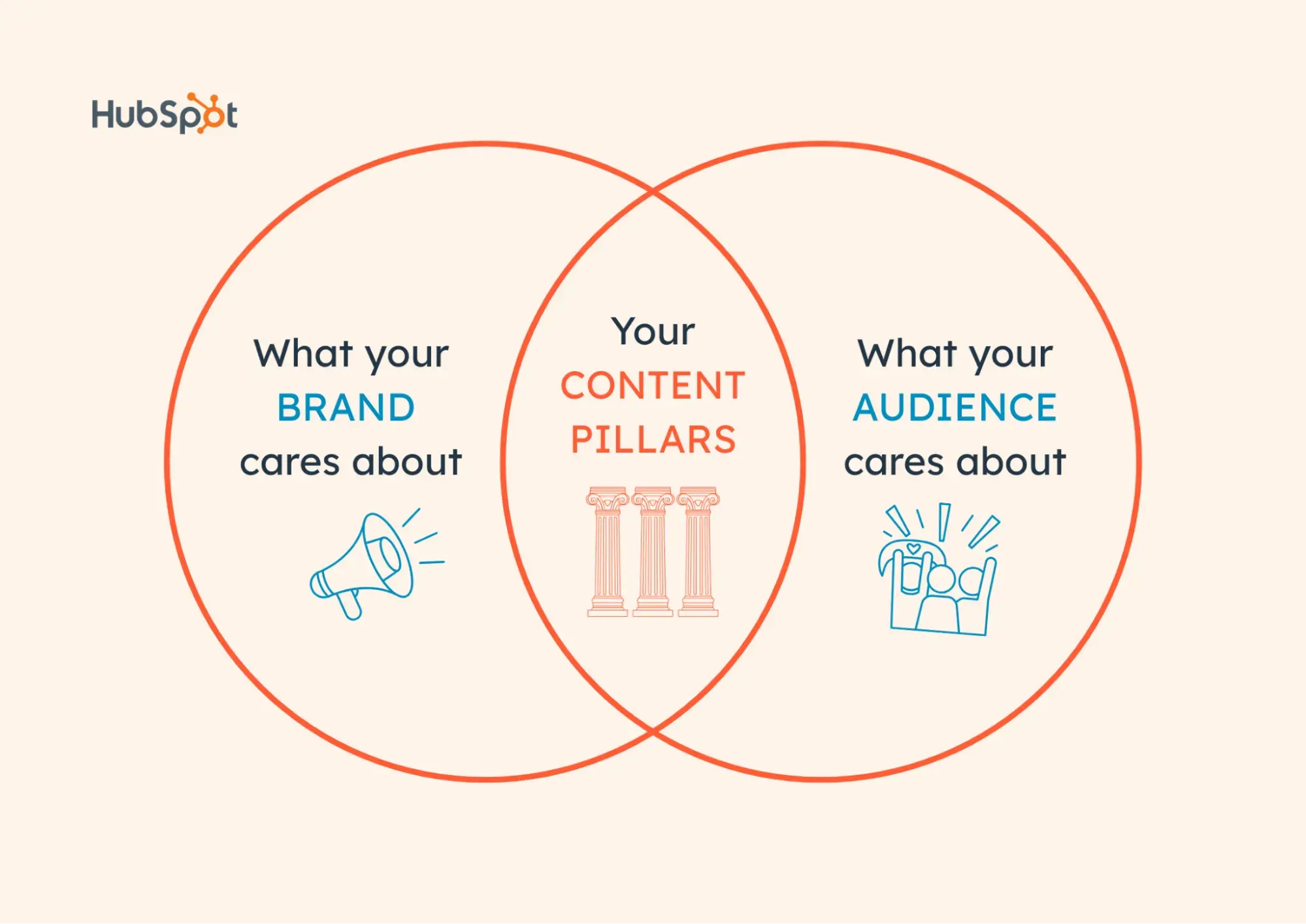
1. Understand your audience.
Start by digging into what your audience actually wants to see. Look at your comments, DMs, survey responses, and analytics. What questions come up again and again? What types of posts get the most saves, shares, or clicks?
The better you understand your audience’s interests and challenges, the easier it is to choose pillars that actually resonate.
Pro tip: Tools like Instagram Insights, LinkedIn Analytics, or even a quick poll can give you direct clues about what types of content your audience actually wants.
2. Audit your existing content.
You probably already have hints about what’s working (and more importantly, what’s not). Go back through your top-performing posts from the past few months and look for patterns. Are your tutorials always getting saved? Are behind-the-scenes reels getting the most comments? Those trends can point you toward natural pillar ideas.
3. Define your brand’s core themes.
Your pillars should reflect what your brand actually stands for — not just what’s trendy. Ask yourself:
- What topics do we want to be known for?
- What expertise or value can we uniquely offer?
- What conversations do we want to lead?
The sweet spot is where your audience’s interests overlap with your brand’s strengths.
4. Choose your core pillars.
Once you know who you're trying to reach and what your brand stands for, focus on picking a few core pillars that feel like the most natural fit. Think about the topics you can genuinely show up for — the ones that spark ideas and conversations, not just fill up your calendar.
You can start by pulling from the examples we covered earlier — or mix in your own based on what fits your brand best. The goal is to have enough variety to keep your content fresh, but enough focus that your messaging stays consistent and recognizable.
Pro tip: Think about balancing emotional pillars (like inspirational or community-building content) with practical pillars (like educational or promotional content).
5. Stay flexible and adapt.
Content pillars aren’t carved in stone. As your audience grows or your brand evolves, you might find yourself adjusting or refining your pillars, and that’s a good thing. Pay attention to what’s resonating and don’t be afraid to tweak your strategy as you learn.
Even starting with a few basic pillars puts you ahead of the curve. Many brands still post randomly, so with a little strategy, you’re already building something stronger.
How to Create Content Pillars for Social Media
Knowing your content pillars is one thing, but building a system that actually uses them is another. Over the years, I’ve helped brands turn loose ideas into full strategies that keep their posting organized, consistent, and surprisingly flexible.
Here’s the process I’ve used (and refined) to help teams bring their pillars to life without losing their creativity along the way.
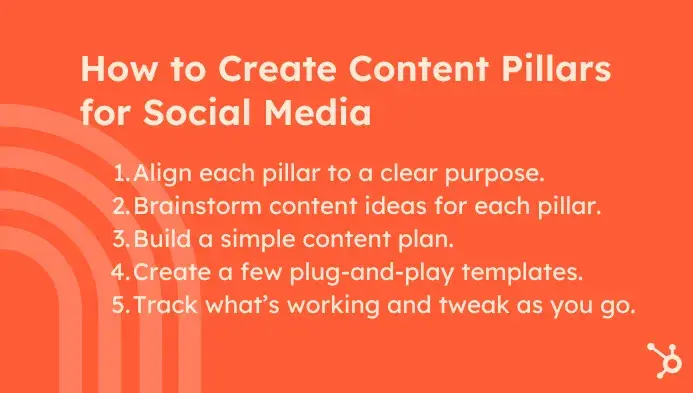
1. Align each pillar to a clear purpose.
Start by connecting each pillar to a bigger-picture goal. Are you trying to build brand awareness? Drive website traffic? Increase engagement? Assigning a purpose to each pillar helps ensure your content is working toward something meaningful.
Pro tip: Not every pillar has to serve the same goal. Your educational content might drive traffic, while your community-building pillar is focused on boosting engagement.
2. Brainstorm content ideas for each pillar.
Once your pillars are aligned with specific goals, it’s time to get creative. For each one, brainstorm a mix of formats that support the theme — think carousels, short videos, stories, infographics, or even live Q&As. The key is to generate ideas that stay true to the pillar's purpose while keeping your content mix fresh.
One trick I use is asking myself, “What does this look like as a how-to? As a story? As a visual post?” That mindset helps me unlock more diverse and engaging ideas without getting off-topic.
3. Build a simple content plan.
Now it’s time to organize those ideas into something you can actually use. You don’t need a complicated system — just a way to make sure you're covering your pillars consistently. That might mean assigning each pillar a day of the week, planning monthly themes, or using a content calendar to map everything out.
Pro tip: Keep it flexible. The goal isn’t to force content into a rigid structure — it’s to give yourself a clear rhythm so you're never starting from scratch.
4. Create a few plug-and-play templates.
Once you know what kinds of posts you want to create for each pillar, make it easier on yourself by building a few ready-made templates. That could mean a weekly Q&A format for community-building, a recurring tip carousel for education, or a product spotlight layout for promotions.
Templates give you a repeatable way to show up without reinventing the wheel every week.
Pro tip: Keep a swipe file of posts you love (from your brand or others) to inspire new formats and frameworks you can test.
If you need a little extra help getting started, HubSpot’s free Content Marketing Workbook is packed with templates and exercises to help you map out your pillars and build a strategy you can actually stick to.
5. Track what’s working and tweak as you go.
Once your system is up and running, the real magic happens in the refinement. Pay attention to which posts are getting saved, shared, or sparking conversations — and like I said before, which ones are falling flat. Over time, those signals will help you double down on what works and adjust the rest.
Pro tip: I like to review pillar performance monthly and jot down what felt good (and what didn’t). Sometimes the best content insights come from your own gut check.
Content Pillars for Social Media Examples
It’s easiest to understand how content pillars work by seeing them in action, so I’ve rounded up a few of my favorite examples.
These brands have done an amazing job of building their social strategies around clear pillars — and it shows. Some have been doing it for years, while others are jumping on new trends in ways that feel fresh, smart, and intentional.
Let’s break down a few of my personal favorites to see how different pillar types show up across industries.
Hubspot (Educational)

I know it might seem biased to mention HubSpot here (given where you're reading this), but honestly, I’ve been obsessed with HubSpot’s content for years — long before working with them.
Their blog, templates, and free resources are a masterclass in educational content done right. Every guide, checklist, and how-to post ties back to their broader mission of helping businesses grow better, while also gently reinforcing the value of their platform.
And while education is clearly one of their biggest strengths, they keep their content feeling fresh by mixing in lighter, more entertaining moments, too. It’s a reminder that even with a strong pillar, variety still matters.
Nike (Inspirational)
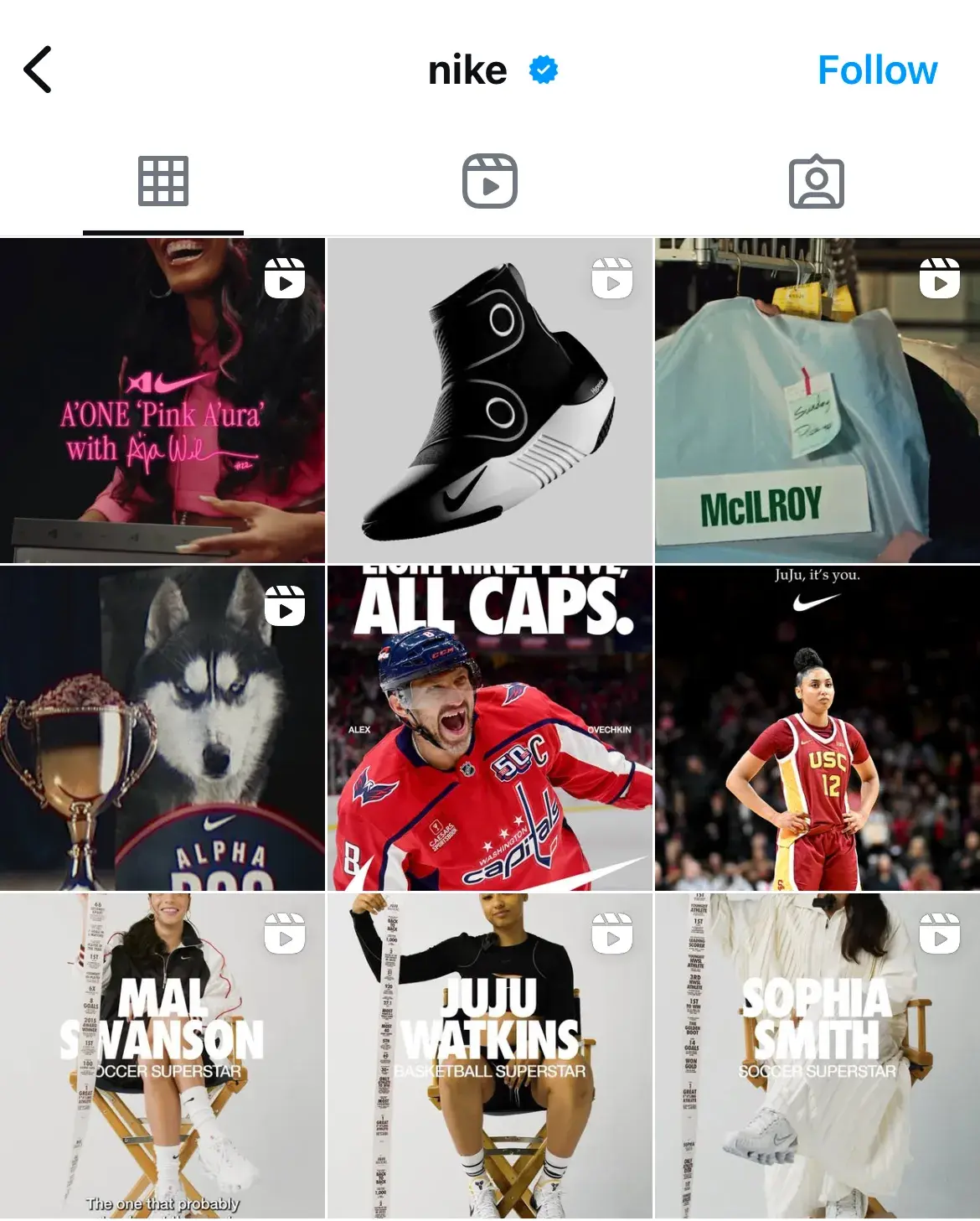
I think Nike is one of the best examples out there when it comes to using inspiration as a core pillar. They don't just sell shoes or workout gear — they sell ambition, perseverance, and self-belief.
From short motivational videos to powerful athlete stories, nearly everything Nike shares feels like a rallying cry. It’s not about the product as much as it is about making you feel something, and then tying that emotion back to their brand.
Poppi (Promotional)
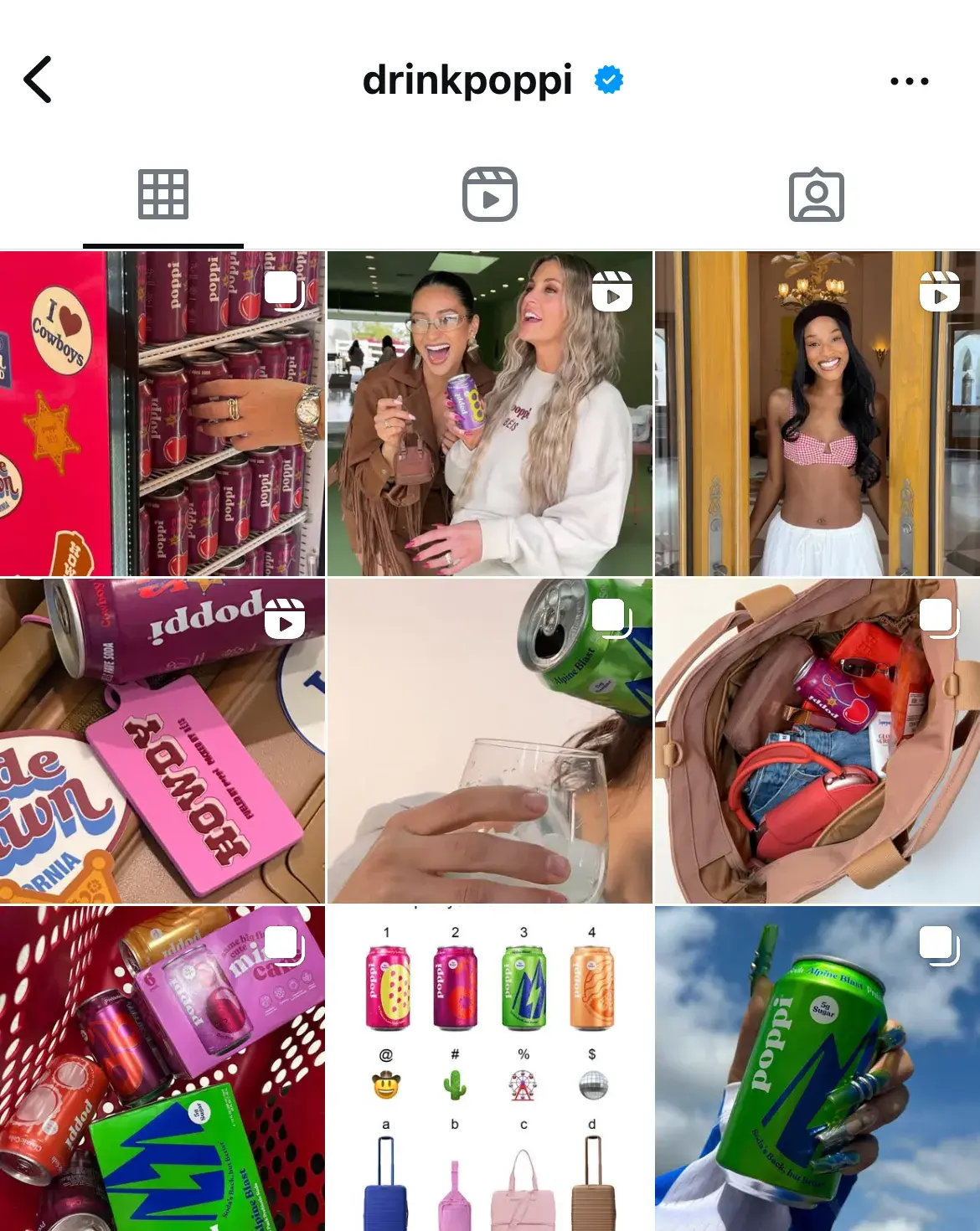
Poppi is a great example of how to do promotional content right. They don’t just post about their gut health sodas: They build an entire lifestyle around feeling good from the inside out.
Their product features are playful, colorful, and tied to moments their audience cares about, like wellness routines, beauty trends, and everyday self-care. It never feels like a hard sell — it feels like an invitation to join a movement. Pop off, Poppi!
Duolingo (Community-Building)
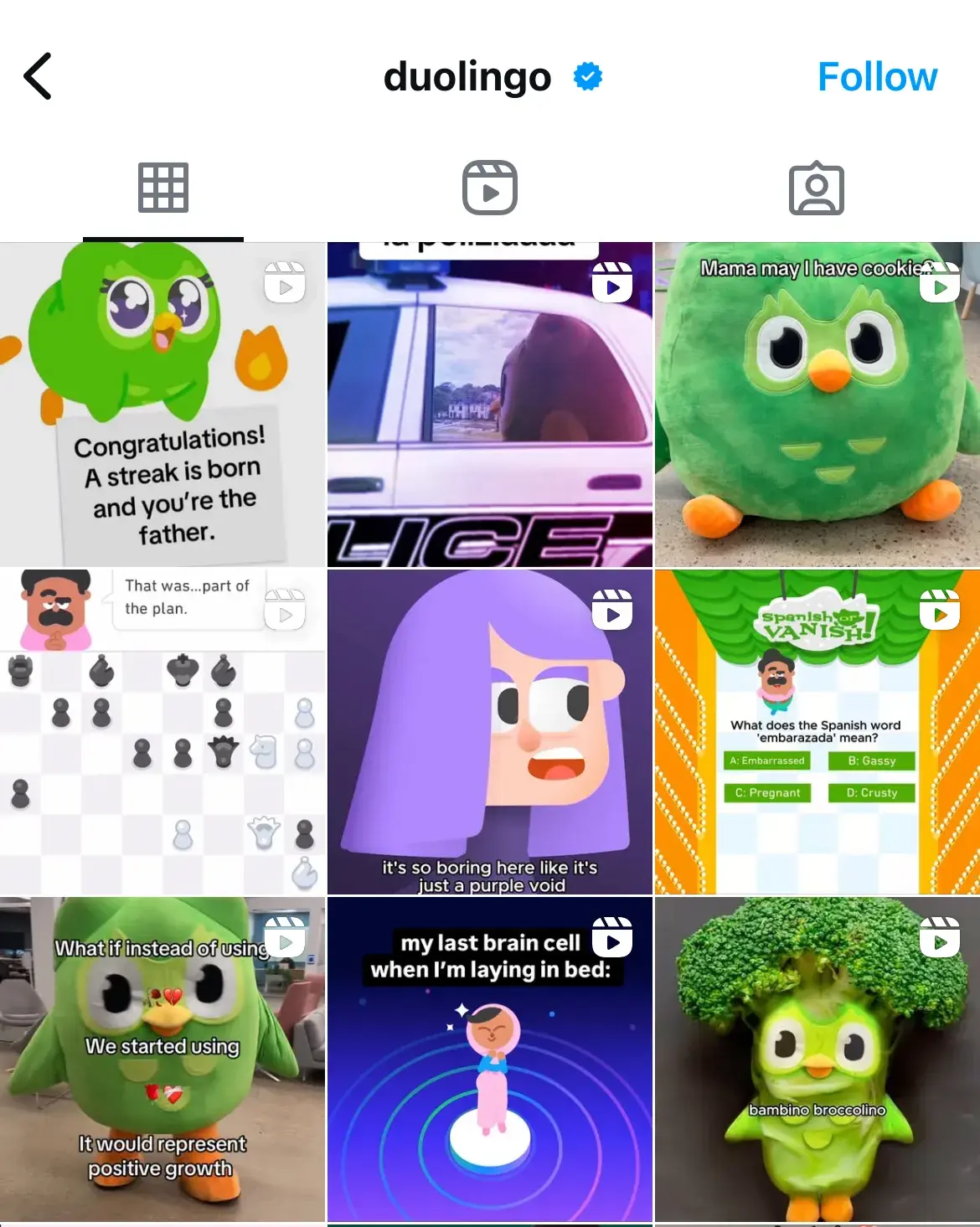
If you’ve spent any time on TikTok or Instagram, or honestly the internet, you’ve probably seen Duolingo’s mascot, Duo, causing chaos — in the best way possible.
Duolingo has mastered the art of community-building by leaning into humor, trends, and audience interaction. Whether it’s jumping on viral challenges, replying to comments with inside jokes, or staging hilarious “dramas” involving their owl mascot (yes, I’m heavily invested), their content invites users to be part of the story.
It’s a perfect example of how showing personality and engaging back with your audience can turn followers into a real community. ‘Til death Duo us part.
Rhode (Behind-the-Scenes)

Rhode, aka Hailey Bieber’s skincare brand, does an amazing job of pulling back the curtain without losing their polished, or should I say “glazed,” feel.
They regularly share glimpses into product development, photoshoots, and everyday brand-building moments. You’ll see behind-the-scenes looks at brainstorming sessions, lab work, packaging decisions, and team wins — all through a lens that feels aspirational but still relatable.
It’s a perfect example of how behind-the-scenes content can make a brand feel more human, even when it's operating at a luxury level.
Take It One Post at a Time
If there’s one thing I hope you take away from this article, it’s that content pillars aren’t about adding more rules to your strategy — they’re about making everything simpler, clearer, and a whole lot more sustainable.
Looking back, the biggest shift I felt after building my first real pillar strategy wasn’t just better engagement rates or easier planning (although those definitely happened). It was confidence. I stopped treating every post like a shot in the dark and started showing up with a sense of purpose.
Remember, your pillars don’t have to be perfect or set in stone. They just have to be real. Start small, stay flexible, and trust yourself to figure it out as you go.
Because when you build your strategy on clarity and connection, everything else gets a lot easier — and a lot more fun, too.





I completely resonate with your experience of feeling overwhelmed when starting out in social media management. That sense of aimlessly “throwing spaghetti at the wall” is so familiar. I recall a similar time when I was managing social media for a small local business; there were days when I would scramble for content, and it felt like no strategy was in place. One day I’d post a behind-the-scenes snapshot, and the next, I’d rush out a sale announcement—always with inconsistent engagement.